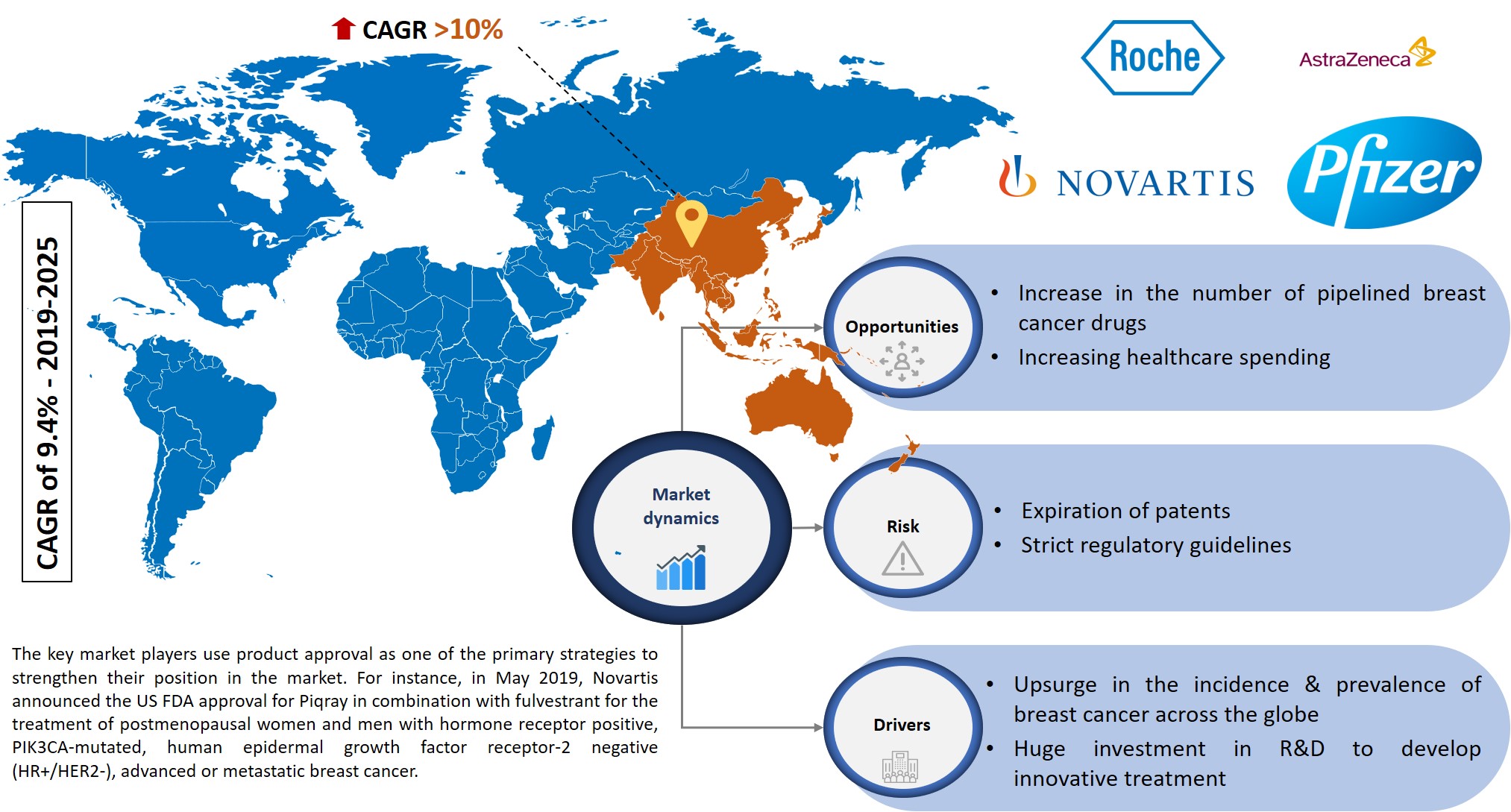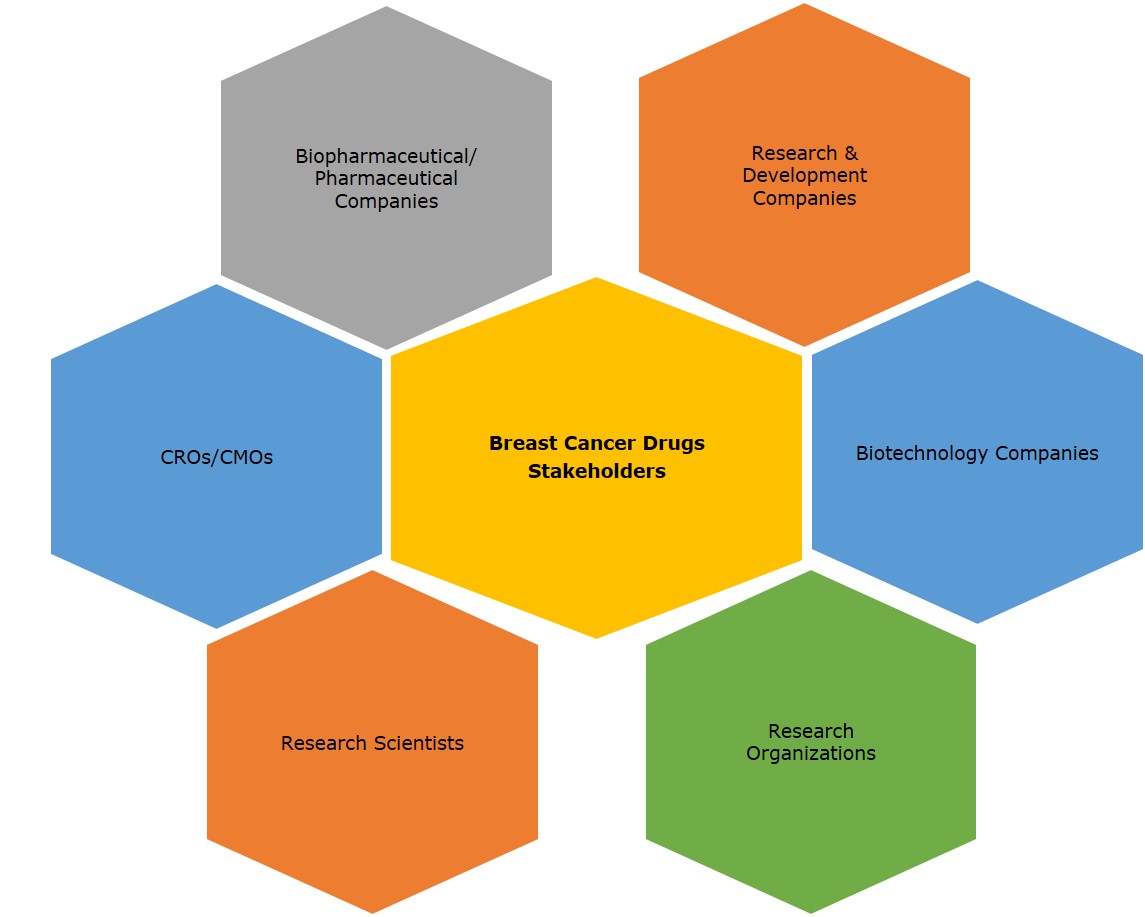
Global Breast Cancer Drugs Market – By Drug Type (HER2 Inhibitors, Mitotic Inhibitors, Anti-metabolites, CDK4/6 Inhibitors, and Hormonal Receptors), By Regions (North America, Europe, Asia Pacific, and Rest of the World): Forecast up to 2025
- January, 2020
- Domain: Healthcare - Pharmaceuticals
- Get Free 10% Customization in this Report
This market research report includes a detailed segmentation of the global breast cancer drugs market by drug type (HER2 Inhibitors, Mitotic Inhibitors, Anti-metabolites, CDK4/6 Inhibitors, and Hormonal Receptors) and by regions (North America, Europe, Asia Pacific, Rest of the World).
Overview of the Global Breast Cancer Drugs Market
Infoholic’s market research report predicts that the “Global Breast Cancer Drugs Market” will grow at a CAGR of 9.4% during the forecast period 2019–2025. Breast cancer is a kind of cancer formed in tissues of the breast. The most common types of breast cancer are ductal carcinoma, which begins in the lining of the milk ducts and lobular carcinoma, which starts in the lobules (milk glands) of the breast. Breast cancer is the most common cancer among women and the second leading cause of cancer-related deaths in women after lung cancer. Advancements in screening and treatment for breast cancer have improved survival rates in the last few decades.

The industry generates majority of the revenue from the key players operating in this field; few of them include Novartis AG, F. Hoffmann-La Roche Ltd., AstraZeneca plc, Pfizer Inc., Johnson and Johnson, Merck Co., Inc., Eli Lilly and Company, Sanofi S.A., Bristol–Myers Squibb, AbbVie Inc., and Macrogenomics Inc.
According to the Infoholic Research analysis, North America accounted for the largest share of the global breast cancer drugs market in 2018 and will retain a high position during the forecast period. North America is followed by Europe, with a share of more than 20% of the global market in 2018.
By Drug Type:
- HER2 Inhibitors
- Mitotic Inhibitors
- Anti-metabolites
- CDK4/6 Inhibitors
- Hormonal Receptors
The HER2 Inhibitors segment occupied the largest share in 2018 and is expected to grow at high-single-digit CAGR during the forecast period. The CDK4/6 inhibitors are expected to grow at a high CAGR during the forecast period 2019–2025. Increasing life expectancy in patients with metastatic hormone receptor (HR)-positive/human epidermal growth factor 2 (HER2)-negative disease and a huge number of drugs in the pipeline make it the fastest-growing segment in the next few years.
By Regions:
- North America
- Europe
- APAC
- RoW
North America is dominant in the global breast cancer drugs market, followed by Europe and Asia Pacific. The significant share of the North America market comes from the US due to the availability of favorable reimbursement policies and the presence of dominant vendors.
Breast Cancer Drugs Market Research Competitive Analysis – The global breast cancer drugs market has massive growth opportunities in both developed and developing regions. There are many new drug launches, approval, funding, and acquisitions related to breast cancer drugs owing to the increased incidence of breast cancer across the globe. For instance, in October 2018, FDA approved Talzenn (talazoparib), a PARP inhibitor to treat BRCA-mutated, HER2-negative locally advanced and metastatic breast cancer based on a trial with 431 patients where participants who received Talzenna saw a 46% reduction in their risk of disease progression compared with those patients who were treated only with chemotherapy. In March 2019, AstraZeneca entered into a global development and commercialization collaboration agreement with Daiichi Sankyo for trastuzumab deruxtecan (DS-8201), a proprietary antibody-drug conjugate and potential new targeted medicine for breast cancer treatment. Both the companies are currently planning to file approval based on the successful Phase II study.
Key Vendors:
- Novartis AG
- F. Hoffmann-La Roche Ltd.
- AstraZeneca plc
- Pfizer Inc.
- Johnson and Johnson
- Merck Co., Inc.
- Eli Lilly and Company
- Sanofi S.A.
- Bristol–Myers Squibb
- AbbVie Inc.
- Macrogenomics Inc.
Key Competitive Facts
- An increase in the incidence & prevalence of breast cancer cases globally, huge investment in R&D to develop an advanced treatment, and numerous initiatives taken by the government to raise disease awareness are few of the factors driving the growth of the breast cancer drugs market.
- The pipeline of cancer drugs in the clinical development has expanded by 45% over the past 10 years; 87% of the late-stage pipeline is targeted therapies, which include small molecule protein kinase inhibitors and biologic monoclonal antibodies.
Benefits – The report provides complete details about the sub-segments of the breast cancer drugs market. Through this report, the key stakeholders can know about the major trends, drivers, investments, vertical player’s initiatives, and government initiatives toward the disease management in the upcoming years along with details of the existing pureplay companies and new players entering the market. Moreover, the report provides details about the major challenges that are going to impact the market growth. Additionally, the report gives complete details about the key business opportunities to key stakeholders in order to expand their business and capture the revenue in specific verticals, and to analyze before investing or expanding the business in this market.
Key Takeaways:
- Understanding the potential market opportunity with precise market size and forecast data.
- A detailed market analysis focusing on the growth of the breast cancer drugs industry.
- Factors influencing the growth of the breast cancer drugs market.
- In-depth competitive analysis of dominant and pure-play vendors.
- Prediction analysis of the breast cancer drugs market in both developed and developing regions.
- Key insights related to major segments of the breast cancer drugs market.
- Latest market trend analysis impacting the buying behavior of the consumers.
Key Stakeholders

- Industry Outlook
- Industry Overview
- Overview
- Global Driver for Pharmaceutical Demand
- R&D Pipeline in the Pharmaceutical Industry
- Industry Trends
- Total Addressable Market
- Industry Overview
- Report Outline
- Report Scope
- Report Summary
- Research Methodology
- Report Assumptions
- Market Snapshot
- Market Definition – Infoholic Research
- Segmented Addressable Market
- Trends in the Breast Cancer Drugs Market
- Related Markets
- Lung Cancer Drugs
- Over-the-Counter (OTC) Drugs
- Respiratory Drugs
- Diabetes Drugs
- Market Outlook
- Market Segmentation
- PEST Analysis
- Porter 5 (Five) Forces
- Market Characteristics
- DRO – Market Dynamics
- Drivers
- Upsurge in the incidence and prevalence of breast cancer across the globe
- Huge investments in R&D to develop innovative treatment
- Opportunities
- Increase in the number of pipelined breast cancer drugs
- Increasing healthcare spending
- Restraints
- Expiration of patents
- Strict regulatory guidelines
- Drivers
- DRO – Impact Analysis
- Key Stakeholders
- DRO – Market Dynamics
- Drug Type: Market Size and Analysis
- Overview
- HER2 inhibitors
- Mitotic Inhibitors
- Anti-metabolites
- CDK4/6 Inhibitors
- Hormonal Receptors
- Regions: Market Size and Analysis
- Overview
- North America
- Europe
- Asia Pacific
- Rest of the World
- Competitive Landscape
- Overview
- Vendor Profile
- Novartis AG
- F. Hoffmann-La Roche Ltd.
- AstraZeneca Plc
- Pfizer Inc.
- Companies to Watch For
- Johnson and Johnson
- Eli Lilly and Company
- Merck Co. Inc.
- Bristol–Myers Squibb
- Sanofi S.A.
- AbbVie Inc.
- Macrogenomics Inc.
Annexure
Abbreviations
Research Framework
Infoholic research works on a holistic 360° approach in order to deliver high quality, validated and reliable information in our market reports. The Market estimation and forecasting involves following steps:
- Data Collation (Primary & Secondary)
- In-house Estimation (Based on proprietary data bases and Models)
- Market Triangulation
- Forecasting

Market related information is congregated from both primary and secondary sources.
Primary sources
involved participants from all global stakeholders such as Solution providers, service providers, Industry associations, thought leaders etc. across levels such as CXOs, VPs and managers. Plus, our in-house industry experts having decades of industry experience contribute their consulting and advisory services.
Secondary sources
include public sources such as regulatory frameworks, government IT spending, government demographic indicators, industry association statistics, and company publications along with paid sources such as Factiva, OneSource, Bloomberg among others.
